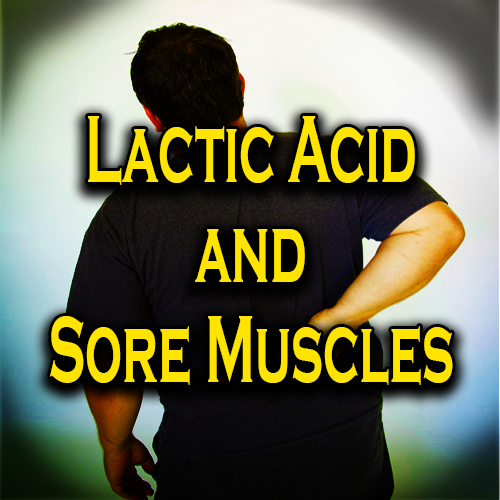Lactic Acid And Sore Muscles

Why does lactic acid build up in muscles?
Lactic Acid and Sore Muscles
Sometimes we work our muscles hard, like in body building or other extreme usage. Then, we make lactic acid to create energy.
A side effect of high lactate levels is a rise in the acidity of the muscle cells. This comes along with disruptions of other metabolites. This is a natural defense mechanism for the body. It blocks permanent damage during extreme exertion. It does this by slowing the key systems needed to maintain muscle contraction. Once the body slows down, oxygen gets usable and lactate turns back to pyruvate. This allows more aerobic metabolism and energy for the body’s recovery from the strenuous event.
Contrary to popular opinion, lactate or, as it is often called, lactic acid buildup is not responsible for the muscle soreness felt in the days following taxing exercise or strength training. As a matter of fact, the production of lactate and other metabolites when you do extreme workout gives a burning feeling. This is most often felt in active muscles. However, which exact metabolites are in the mix remains to be seen. Also, many times this feeling of pain gets us to stop working the body so hard. This makes us take a recovery period. That lets the body clear the lactate and other metabolites.
DOMS
Those who have studied lactate levels just after exercise find little relation to the level of pain in muscles felt a few days later. This delayed-onset muscle soreness, or DOMS as it is called by exercise physiologists, is marked by the occasion of severe muscle tenderness. Also, you see a loss of strength and range of motion. This usually reaches a peak 24 to 72 hours after the extreme exercise event.
Though they still look for the cause of DOMS, most study points to actual muscle cell damage. Also, they see an elevated release of various metabolites into the tissue around the muscle cells. This response sto extreme exercise results in an inflammatory repair response. The reaction leads to swelling and soreness. The soreness peaks a day or two after the event and heals a few days later. They find it all depends on how bad the damage shows.
In this case, exercises that involve many eccentric contractions, such as downhill running, will give the most severe DOMS. You find this even without any notable burning sensations in the muscles during the event.
To Use Or Not To Use Anti-Inflammatory Medicine
Delayed-onset muscle soreness in response to extreme exercise is so common. So, exercise physiologists are actively researching the potential role for anti-inflammatory drugs and other supplements. They’re trying to prevent and treat such muscle soreness. However, no conclusive recommendations are currently available. Also, anti-inflammatory drugs do appear to reduce the muscle soreness – a good thing. However, they may slow the ability of the muscle to repair the damage. This causes negative consequences for muscle function in the weeks following the strenuous event.
I would bet that it is some soreness due to the exercise not the lactic acid. Ice baths (although not fun) really help to reduce soreness after exercise. However if the soreness is already present stretching is the best cure.
I am an avid runner and know about this one all too well! You might try a hot bath, whirlpool, sauna or steam room. These may be the best therapy. Also, you need to consider rest and time spent in therapy.
Stephen M. Roth, a professor in the department of kinesiology at the University of Maryland, explains. http://www.scientificamerican.com/article/why-does-lactic-acid-buil/
| Tags | Category | Author |
|---|---|---|
| Tags: exercise | jerry |